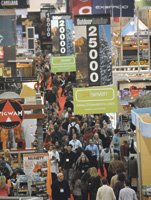Speed-to-Market
What are the keys to success for the fastest-growing apparel-related trade shows?
For every story of business success, someone else found equal success doing the exact opposite.
Take, for example, the clicheacute; “You have to spend money to make money.” Sometimes it’s quite true, as in the case of apparel trade events Moda Manhattan and Accessories The Show, which have found success by reinventing themselves on a seasonal basis. But success can also be achieved simply by being wise to current trends while consistently offering attendees a well-edited selection of exhibitors, as does apparel show Outdoor Retailer. Despite their differences, all three shows are thriving, and, indeed, have each made it into Tradeshow Week’s recent list of the 50 fastest-growing trade shows.
For Moda Manhattan and Accessories The Show, both owned by Business Journals Inc., each season is a time for reinvention. “We approach every season as though it’s a brand-new show,” says Britton Jones, president and chief executive officer of Business Journals. “A lot of trade show producers get to the point where they go on a maintenance program. We don’t. We do a full marketing campaign both to our exhibitors and attendees every single season. It’s a lot of work and costs a lot more money to do it that way, but it keeps the show fresh and exciting.”
Constant reinvesting in the two shows, which Business Journals approaches with the same marketing strategy, has brought growth rates in the double digits in both net square footage and number of attendees.
New exhibitors and new attendees are mutually dependent: You can’t have one without the other. “As we’ve grown in net square footage, we’ve always produced a corresponding increase in attendance,” Jones says.
To lure exhibitors, Jones says Business Journals spends “mass amounts of money” on advertising, direct mail, telemarketing and Web presence. In turn, she says, buyers are drawn by the promise of seeing something new. Fresh exhibitors are grouped together so their collective impact is more powerful to the buyers, and Business Journals’ marketing department courts buyers year-round to ensure that exhibitors will be writing new business, not just repeat business.
Keeping the shows feeling fresh is also paramount—especially considering they are for the fashion industry, which thrives on novelty. While show logos remain consistent, each season brings a new look inspired by the latest color trends. “For designers to have a vibrant line, they need to reinvent it and update it constantly, and that’s what we do with the shows,” Jones says.
Adds Sharon Enright, general manager of Business Journals’ trade show division: “When you represent the fashion industry, you have to stay ahead of the curve in terms of how you present yourself so you can speak to the industry in terms of trends and what’s happening. We’re always looking for new ways to make the show a fresh experience.”
While Moda Manhattan and Accessories The Show are trade shows and thus geared toward business, they are produced like entertainment events. That means a constant courting of new sponsors, such as Jose Cuervo tequila or Dasani water.
Never underestimate the importance of nourishment, “an important element that creates an experience that helps make the connection even better between buyer and seller,” Enright says. Both shows offer free breakfast and lunch catering and all the cappuccinos, smoothies and bottles of water you can drink.
Finally, there’s no better way to improve a show and keep it growing than by getting feedback directly from participants on both sides of the business equation. Both Moda Manhattan and Accessories The Show perform extensive surveys after each show from which organizers have learned things like buyers’ and exhibitors’ universal preference for wide aisles that reduce jostling. “Surveys just provide constant feedback on what you can improve,” Enright says.
Moda Manhattan and Accessories The Show are each held concurrently seven times a year, five times in New York and twice in Las Vegas. Outdoor Retailer is riding the wave of a broader social trend: America’s increased interest in outdoor fitness apparel. But the trade show isn’t just coasting along; it is actively maximizing the benefit of that trend through the targeted recruitment of new exhibitors.
Now in its 27th year, Outdoor Retailer has grown by 30 percent in net square footage since the year 2000, while growing buyers by 15 percent, to 22,000. The show, owned by Nielsen Business Media, has prospered thanks to a rising overall demand for outdoor apparel, even though usership on America’s trails and waterways is actually declining, says Kenji Haroutunian, Nielsen’s show director for the outdoor group. “The look is more popular than the activities themselves,” he says.
As a result, footwear and apparel are Outdoor Retailer’s fastest-growing categories; the trade show’s other categories include hard equipment for things like camping and mountain climbing.
The growing prevalence of casual dress for both work and play, combined with a convergence of fashion and technical elements in outdoor apparel, are likely reasons for the category’s growth, Haroutunian says.
As utilitarian gear has become more fashionable, and as companies such as Patagonia have found new fans with their environmentally conscious clothing, Outdoor Retailer’s buyer and exhibitor bases have expanded. While the show is happy to ride this trend wave, it also works hard on targeting a list of 50 to 80 exhibitors and convincing them they belong at Outdoor Retailer. “We prospect companies we think will be a good fit,” Haroutunian says. “We’re not just going after the biggest companies with the most marketing dollars. We’re looking for ones that will be successful in our marketplace.” These exhibitors are often found at other trade shows, such as the MAGIC Marketplace and the Natural Products Expo.
Outdoor Retailer is also benefiting as the green trend, which has been picking up a head of steam in the industry, goes mainstream. Quality is no longer the only compelling story for buyers, notes Haroutunian, who says they are much more motivated by a manufacturer with a compelling environmental story.
Outdoor Retailer is held twice a year in Salt Lake City.























